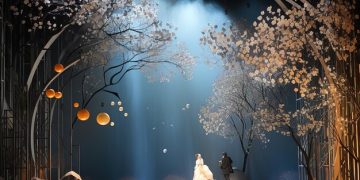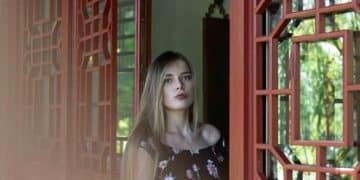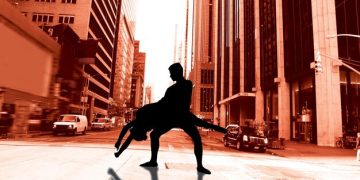K-Drama Cinematography: Visual Storytelling in 3 Award-Winners

K-Drama cinematography masterfully employs visual storytelling techniques, merging artistic camera work, lighting, and mise-en-scène to create immersive narratives, as seen in acclaimed series such as “Crash Landing on You,” “Vincenzo,” and “Squid Game,” each leveraging unique visual elements to enhance plot and character depth.
Delve into the captivating world of K-dramas, where visual artistry often rivals the intricate plots and compelling characters. This article unveils how K-Drama Cinematography: Analyzing the Visual Storytelling Techniques Used in 3 Award-Winning Series elevates these shows from mere entertainment to profound cinematic experiences, exploring the innovative methods behind their global appeal.
The Art of Visual Storytelling in K-Dramas
K-dramas have cemented their place on the global stage, captivating audiences not just with compelling narratives and charismatic leads, but also with their exceptional visual storytelling. This isn’t merely about beautiful shots; it’s about how every frame, color, and camera movement meticulously contributes to the overall emotional and narrative impact. Cinematography in these series is a deliberate art form, meticulously crafted to draw viewers deeper into the story.
The visual language of K-dramas transcends cultural barriers, using universal cinematic techniques to convey complex emotions and subtle plot points. From sweeping landscapes that symbolize grandeur and escapism to intimate close-ups that reveal a character’s inner turmoil, each element is thoughtfully composed. This approach creates an immersive experience, allowing viewers to “feel” the story rather than just watch it unfold.
Furthermore, the high production value typical of many award-winning K-dramas ensures that these visual elements are executed with precision. Whether it’s intricate set design, elaborate costume choices, or realistic special effects, the visual aesthetic is always a priority. This commitment to visual excellence is a key differentiator, setting K-dramas apart in the competitive world of television.
Symbolism through Color and Light
Color palettes in K-dramas are rarely arbitrary; they often serve as powerful narrative tools. Vibrant hues might signify joy or passion, while muted tones can evoke melancholy or suspense. Similarly, lighting is manipulated to shape mood, highlight character traits, or foreshadow events.
- Emotional Resonance: Specific colors are often recurring motifs, linked to certain characters, themes, or emotional states throughout a series.
- Atmospheric Depth: Strategic lighting can transform a simple scene into a dramatic or poignant moment, playing on shadows and highlights.
- Character Development: The evolution of a character might be subtly underscored by changes in their associated color scheme or how they are lit.
The interplay of color and light is particularly evident in establishing the tone of a series. A romantic comedy might bathe its scenes in warm, bright light, while a gripping thriller opts for stark contrasts and darker shades. This visual vocabulary enriches the narrative, often communicating information without a single word being spoken.
Ultimately, understanding the visual storytelling techniques in K-dramas enhances the viewing experience. It transforms passive watching into an active engagement with the artistry on screen, revealing layers of meaning that might otherwise go unnoticed. This deliberate approach to cinematography is a cornerstone of why these series resonate so deeply with a global audience.
“Crash Landing on You”: Grandeur & Intimacy through Lens
“Crash Landing on You” (2019) captivated millions with its extraordinary premise and undeniable chemistry, but its cinematic prowess deserves equal acclaim. The series masterfully balances vast, breathtaking landscapes with intensely personal moments, largely thanks to its discerning cinematography. This visual approach was crucial in portraying the stark contrast between two worlds and the bond that defied their boundaries.
The initial distinction between South Korea’s vibrant, modern cityscape and North Korea’s more austere, natural beauty was exquisitely rendered through camera work. Sweeping drone shots showcased the expansive wilderness of the North, emphasizing the isolation and unexpected charm of Se-ri’s new surroundings. These wide shots not only established geographical context but also underscored the dramatic scale of her predicament, making her journey feel epic.
In contrast, scenes set in South Korea were often characterized by dynamic urban shots, reflecting its bustling modern life. This visual dichotomy, achieved through varied framing and environmental composition, immediately immerses the viewer in the differing realities of the protagonists. It’s a subtle yet effective way of communicating the character’s emotional journey and cultural shifts.
Camera Work for Emotional Depth
The cinematography in “Crash Landing on You” excels at bridging the gap between grand spectacle and intimate character interactions. Close-ups during emotional exchanges are frequent, allowing the audience to fully absorb the nuances of facial expressions and silent dialogues. These moments are often framed such that external elements fade, focusing solely on the characters’ vulnerability and connection.
- Personal Perspective: Frequent use of point-of-view shots places the audience directly in the characters’ shoes, deepening empathy.
- Soft Focus: Often used in romantic scenes, a soft focus blurs backgrounds, drawing attention to the tender interactions between Yoon Se-ri and Ri Jeong-hyeok.
- Movement and Stillness: The camera movements themselves reflect the narrative pace, becoming more fluid during lighthearted moments and more stable during poignant or dramatic revelations.
Moreover, the use of a shallower depth of field in intimate moments visually isolates the main characters, emphasizing their bond against the backdrop of their challenging circumstances. This technique highlights the idea that their connection exists in a world of its own, separate from the political and geographical divides. It’s a powerful visual metaphor for their undeniable love.
The series also frequently employs symmetrical framing, particularly in scenes depicting unity or shared understanding between characters. This creates a sense of balance and harmony, even amidst conflict or personal struggle. Such thoughtful framing doesn’t just look aesthetically pleasing; it subtly reinforces narrative themes of partnership and mutual support, making “Crash Landing on You” a masterclass in using cinematography for emotional and thematic resonance.
“Vincenzo”: Stylish Symmetry and Dark Humor
“Vincenzo” (2021) broke molds with its unique blend of dark comedy, legal thriller, and anti-hero justice, all underlined by a distinctive stylistic cinematography. The drama’s visual storytelling perfectly complements its cynical yet charming protagonist, Vincenzo Cassano, and the morally ambiguous world he navigates. The core of its visual identity lies in its meticulous composition and bold aesthetic choices that amplify its satirical tone.
A striking feature of “Vincenzo”‘s cinematography is its prevalent use of symmetry and geometric framing. From the imposing architecture often featured to the precise arrangement of characters within a scene, everything is meticulously composed. This visual orderliness contrasts sharply with the chaos and corruption the characters face, creating an ironic tension that is central to the show’s dark humor. It evokes a sense of controlled chaos, much like Vincenzo himself.
The series often uses long takes and tracking shots to build suspense and allow the audience to observe the detailed environment and character interactions without interruption. These techniques contribute to a theatrical feel, almost as if watching a play unfold, further enhancing the drama and the deliberate nature of Vincenzo’s actions. The result is a visually rich experience that keeps the viewer engaged on multiple levels.
Lighting and Color in a Morally Grey World
The lighting and color palette in “Vincenzo” are critical in establishing its sophisticated, often morally ambiguous atmosphere. The show frequently utilizes deep, rich colors—think luxurious golds, dark blues, and crimson reds—that evoke power, wealth, and danger. The lighting is often dramatic, with strong contrasts between light and shadow, particularly in scenes involving confrontation or contemplation.
- Neo-Noir Influence: The heavy use of shadows and high contrast lighting gives many scenes a modern neo-noir aesthetic, reflecting the protagonist’s morally complex character.
- Golden Hues: Gold, a color associated with wealth and power, is used prominently in set dressings, costumes, and even lighting gels, reinforcing the show’s themes of greed and luxury.
- Strategic Color Blocking: Characters’ costumes often employ powerful color blocking, visually separating them or aligning them with certain factions, adding another layer to the visual narrative.
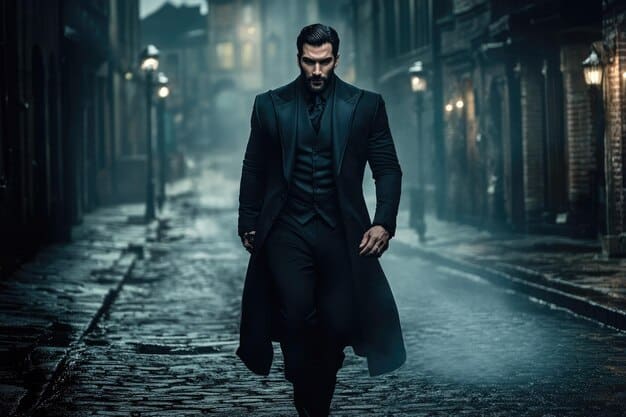
This deliberate manipulation of light and color not only creates a visually stunning experience but also deepens the narrative. It helps in communicating the psychological states of characters and the underlying themes of corruption versus justice. The aesthetic choices are never just for show; they are integral to the storytelling, adding depth to the humor and gravity to the critical moments.
Ultimately, the cinematography of “Vincenzo” acts as a silent commentator, subtly guiding the audience’s perception and emotional response. Its stylish symmetry and sophisticated use of color and light are key elements that make the series an unforgettable visual journey, distinguishing it as a masterclass in blending style with substance. This visual boldness is critical to its distinctive appeal and award-winning status.
“Squid Game”: Subversive Simplicity and Symbolism
“Squid Game” (2021) burst onto the global scene not just for its gripping plot and brutal social commentary, but for its strikingly distinctive cinematography. The series employs a visual language that is paradoxically both simple and deeply symbolic, using elements like vibrant colors, minimalist sets, and unsettling compositions to convey its profound themes of inequality and human desperation. Its camera work is a character in itself, constantly observing, revealing, and questioning.
One of the most immediate visual impressions of “Squid Game” is its use of bright, almost childlike colors contrasting sharply with the grim reality of the games. The often-saturated palette for sets and costumes—particularly the iconic tracksuits and guard uniforms—initially creates a deceivingly playful atmosphere. This visual ploy heightens the shock when the horrific nature of the games is revealed, underscoring the show’s dark satire.
The settings for the games themselves are often vast, enclosed spaces, meticulously designed to feel both expansive and claustrophobic. The use of wide-angle shots in these arenas emphasizes the sheer number of participants, reducing them to mere pixels in a grand, twisted experiment. This perspective immediately communicates the dehumanizing aspect of the competition, making individuals feel small and insignificant against the monolithic structure of the game.
Framing and Composition for Psychological Impact
The cinematography in “Squid Game” is adept at using framing and composition to generate a profound psychological impact. The camera often remains static during pivotal moments, allowing the intensity of the scene to speak for itself without distraction. This deliberate stillness forces the viewer to confront the raw emotions and brutal realities unfolding on screen.
- Symmetry of Despair: Often, characters are framed symmetrically within stark, empty spaces, highlighting their isolation and the uniformity of their impending fate.
- High and Low Angles: High-angle shots frequently reduce characters to vulnerable figures, controlled by an unseen authority, while low angles can elevate the mysterious game masters, conveying their power.
- Tracking Shots in Confined Spaces: Paradoxically, tracking shots are used within the seemingly limitless game arenas to underscore the constant surveillance and lack of escape for the participants.
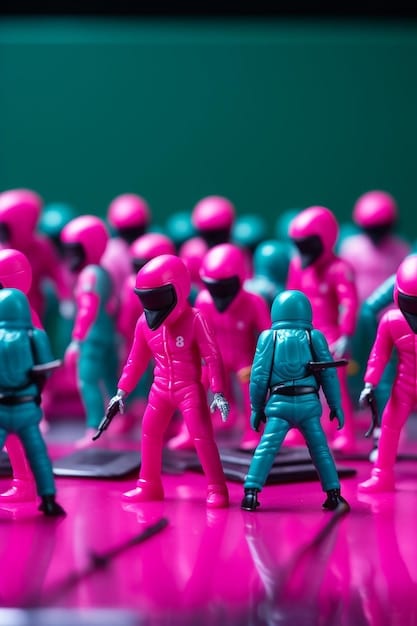
The show also frequently employs deep focus, ensuring that even elements in the background are sharp. This technique allows viewers to absorb every detail of the meticulously designed sets, which often hold symbolic meaning or foreshadow future events. It encourages a more active engagement, making seemingly innocuous background elements part of the larger narrative puzzle.
Ultimately, “Squid Game”‘s cinematography is a masterclass in visual irony and emotional manipulation. By juxtaposing seemingly innocent visuals with grim realities and using precise framing to manipulate perspective, the series creates an unforgettable, unsettling experience. This subversive approach to visual storytelling cemented its status as a global phenomenon and an award-winning series.
Evolution of K-Drama Cinematography
The visual quality of K-dramas has undergone a remarkable evolution over the past decade, moving from straightforward, functional camera work to sophisticated, art-house-level cinematography. This shift is not merely about technological advancements but reflects a growing artistic ambition and a deeper understanding of visual storytelling as an integral component of narrative delivery. The global success of K-dramas has fueled this evolution, pushing production teams to continually innovate.
Early K-dramas often relied on more conventional camera angles and lighting, prioritizing clear communication of plot over aesthetic complexity. While effective, this approach sometimes resulted in a less distinctive visual style. As the industry matured and competition increased, there was a clear drive to differentiate products through visual flair.
With greater investment and creative freedom, cinematographers began experimenting with more daring techniques. This included the adoption of cinematic aspect ratios, the integration of extensive CGI and visual effects, and a more deliberate use of color grading to establish mood and thematic resonance. These advancements allowed for more ambitious visual narratives, capable of drawing in a wider international audience.
Technological Advancements and Their Impact
Technological leaps have played a pivotal role in elevating K-drama cinematography. The widespread availability of high-definition cameras, advanced drones, and sophisticated post-production software has opened up new possibilities for visual expression. This has allowed directors of photography to create stunning visuals that were once exclusive to big-budget films.
- Drone Cinematography: Offers breathtaking aerial views, essential for capturing expansive landscapes and dynamic chase sequences.
- Advanced Color Grading: Provides precise control over the final look and feel of a scene, enhancing emotional impact and visual consistency.
- Stabilization Technology: Enables smoother, more fluid camera movements, crucial for creating immersive action sequences or elegant character introductions.
The impact of these technologies extends beyond mere aesthetics; they have fundamentally reshaped how stories are told visually. Complex camera movements that convey chaos or precision, dynamic transitions that propel the narrative forward, and detailed close-ups that highlight subtle emotions are now standard. This technical mastery ensures that K-dramas can compete on a global scale, offering a cinematic experience on the small screen.
Furthermore, the increased focus on visual quality has attracted world-class cinematographers and visual effects artists to the K-drama industry. Their expertise contributes to the overall polish and sophistication seen in many contemporary series. This ongoing commitment to visual excellence is a key factor in the continued rise and global appeal of K-dramas, ensuring they remain at the forefront of television production.
The Global Influence of K-Drama Visuals
The distinct visual storytelling of K-dramas has undeniably left a significant mark on global entertainment. Their innovative use of cinematography, characterized by high aesthetic standards and a meticulous approach to visual symbolism, has not only garnered international awards but has also influenced production techniques worldwide. This global recognition underscores the universal appeal of compelling visual narratives.
K-dramas have demonstrated that strong visual aesthetics can transcend language barriers, making narratives more accessible and impactful for a global audience. The emphasis on beautiful scenery, stylish set designs, and artistic camera angles has become a benchmark, inspiring other national film and television industries to elevate their own visual production values. It’s a testament to the power of non-verbal communication in storytelling.
Moreover, the success of K-dramas has fostered a greater appreciation for the role of the cinematographer in television production. No longer seen as merely technical support, cinematographers are now recognized as core creative partners, whose vision is essential to shaping the final product. This elevated status has led to more experimental and artistic approaches across the industry.
Inspiring New Production Standards
The visual audacity and consistent quality of K-dramas have set new standards for television production globally. From sweeping historical epics to intimate modern romances, the visual grammar employed is often exceptional, proving that television can achieve cinematic grandeur. This has pushed other regions to reconsider their own approaches to visual storytelling.
- Emphasis on Aesthetics: Many international productions now prioritize visual appeal and artistic composition, drawing inspiration from K-drama techniques.
- Innovative Camera Work: The adventurous camera movements and unique framing seen in K-dramas are being emulated in various global series.
- Detailed World-Building: The meticulous attention to detail in set design and production value, a hallmark of K-dramas, is being adopted to create more immersive fictional worlds elsewhere.
The influence can also be seen in how stories are adapted for different platforms, with visual impact being a key consideration. K-dramas often utilize a visual brevity, conveying complex emotions and plot points through single frames or short sequences. This lean, impactful visual language is highly effective in a world of shrinking attention spans and diverse viewing habits across devices.
In essence, the global influence of K-drama visuals extends beyond mere imitation. It is about a paradigm shift in how television narratives are conceived and executed, placing cinematography at the heart of the storytelling process. This ongoing legacy ensures that K-dramas will continue to be a force of innovation in the global entertainment landscape for years to come.
Future Trends in K-Drama Cinematography
As K-dramas continue to dominate global viewership charts, their cinematography is not resting on its laurels. The industry is constantly exploring new frontiers, pushing technological boundaries and experimenting with innovative storytelling techniques. The future promises an even more immersive and visually stimulating experience, driven by technological advancements and evolving audience expectations. We are on the cusp of a new era of visual spectacle.
One major trend is the increased integration of virtual production techniques, including LED walls and real-time rendering. This allows for highly realistic and dynamic backgrounds, giving filmmakers unprecedented control over environmental storytelling without the need for extensive location shoots. Such technology will enable even more fantastical and detailed worlds to be created directly on set.
There’s also a growing exploration of unconventional aspect ratios and camera formats, moving beyond the traditional. This experimentation aims to create unique visual signatures for each series, further distinguishing them in a crowded market. The goal is to match the visual presentation perfectly with the narrative’s tone and thematic depth, offering a tailored viewing experience.
AI and Interactive Visuals
The rise of artificial intelligence (AI) is also poised to transform K-drama cinematography. AI tools can assist with everything from initial shot composition and lighting design to advanced post-production effects. This can streamline workflows, allowing cinematographers to focus more on the creative aspects and less on repetitive technical tasks.
- AI-Assisted Shot Design: AI algorithms could suggest optimal camera angles and movements based on script analysis and emotional cues.
- Dynamic Lighting Systems: Automated lighting rigs leveraging AI can create complex, adaptive lighting schemes that respond in real-time to character movements or narrative beats.
- Enhanced Visual Effects: AI will make sophisticated visual effects more accessible and seamless, blurring the lines between practical and digital cinematography.
Furthermore, we might see a move towards more interactive visual elements, especially with the growth of immersive viewing experiences like virtual reality (VR) and augmented reality (AR). While full integration into linear K-dramas is still nascent, elements of interactive viewing could begin to appear, allowing audiences to explore narrative spaces in new ways. This would transform viewing into an even more participatory experience.
In conclusion, the future of K-drama cinematography is bright and dynamic, continually evolving to meet new narrative demands and technological possibilities. These innovations will not only maintain the industry’s visual leadership but also continue to redefine what is possible in televised storytelling, ensuring K-dramas remain at the cutting edge of global entertainment.
| Key Aspect | Brief Description |
|---|---|
| 🎨 Color & Light | Used for emotional resonance, atmosphere, and character development, often carrying symbolic weight. |
| 🎥 Camera Techniques | Includes sweeping shots for grandeur, close-ups for intimacy, and unique framing for psychological impact. |
| 🎭 Set & Prop Design | Meticulously crafted to enhance world-building, thematic meaning, and character context. |
| 💡 Innovation & Future | Continuously evolving with new technologies like AI and virtual production for immersive experiences. |
Frequently Asked Questions About K-Drama Cinematography
K-drama cinematography stands out due to its artistic fusion of visual aesthetics, symbolic use of color, intricate set designs, and often daring camera movements. It meticulously crafts each frame to enhance emotional depth and narrative tension, consistently delivering high production value that often rivals feature films. This dedication to visual excellence elevates storytelling beyond dialogue alone.
Cinematography subtly aids character development by using lighting to symbolize inner states, color palettes to reflect personality shifts, and framing to emphasize isolation or connection. A character’s journey can be visually underscored by changes in how they are shot—from vulnerable close-ups to empowered wide shots—offering non-verbal insights into their evolving personality and motivations.
Yes, romantic scenes in K-dramas often employ specific techniques to heighten intimacy and emotional impact. These include soft focus to create a dreamy aesthetic, shallow depth of field to emphasize the couple while blurring distractions, and warm lighting to evoke tenderness. Slow-motion sequences and close-ups on hands or faces are also common to capture delicate romantic gestures and deep emotional connections.
K-dramas masterfully balance grand visuals with intimate moments by skillfully transitioning between wide, expansive shots that establish setting and scale, and tight close-ups that focus on character emotions. This dynamic range prevents visual fatigue and keeps the audience engaged, allowing for both breathtaking spectacles and deeply personal character beats within the same narrative arc. The contrast amplifies both.
Set design and locations are crucial in K-drama cinematography, often acting as extensions of the narrative itself. They are meticulously chosen or constructed to reinforce themes, convey socioeconomic status, and even symbolize character states. From opulent palaces to quaint neighborhoods, every setting is a deliberate visual choice that enriches the storytelling and creates an immersive world for the viewer.
Conclusion
The journey through the cinematography of “Crash Landing on You,” “Vincenzo,” and “Squid Game” reveals a profound truth: K-drama visuals are not merely decorative but integral to their narrative power. Each series leverages distinct visual techniques—from grandeur and intimacy to stylishymmetry and subversive simplicity—to weave compelling stories that resonate deeply with audiences worldwide. This meticulous attention to visual detail, coupled with a willingness to experiment, solidifies K-dramas’ reputation as pioneers in global television storytelling. Their continued evolution promises a future where visual narratives remain at the forefront, continually captivating and inspiring viewers across cultures.
